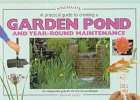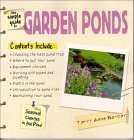
![]()
Maintenance |
|
WORTH A LOOK |
|
Creating a Garden Pond and Year-Round Maintenance |
|
The Water Garden Encyclopedia |
|
RHS Water Gardening |
|
POND MAINTENANCE
This describes the yearly maintenance of an ornamental pond.
1 - The need for maintenance
No other garden feature deteriorates so quickly as a garden pond if it is not maintained adequately. As there is a constant supply of water, plant growth is vigorous and fast, resulting in overgrown plants in a short time if they are not cut back. The water chemistry is finely tuned between several organisms and if one gets out of hand the whole balance can be upset and the pond will go green.
2 - Spring maintenance
In certain pools, like wildlife pools, the dead foliage from the previous year may have been left on for the winter protection of birds and animals. This can now be removed and cut back to just above the emerging shoots. Divide crowded or overgrown plants. If uprooting suspected winter casualties check for live buds near the roots. Feed aquatic plants especially waterlilies with slow-release fertiliser. When the water temperature rises above 5-6C start feeding fish with low protein food.
3 - Summer maintenance
Deadhead flowering plants where decorative seedheads are not desired. Remove yellowing leaves and old flowers of waterlilies. Remove any blanketweed before it spreads. Keep checking the growth of submerged oxygenators, taking cuttings from the tips where necessary. Top up the pond if necessary, using stored rainwater wherever possible. Keep any fountains running at night in sultry weather. Regulate fish feeding as more natural foods become available to them.
4 - Autumn maintenance
As the growing season ends, collect any plant material intended for propagation purposes that need shelter for the winter, and remove any tender aquatics for winter storage. Secure a net over the pond to collect falling leaves and debris. Remove any dying stems from the water. Cut back excess growth from oxygenators. Remove part of the dying foliage from tall containerised marginals to prevent them blowing over in winter gales. Feed high protein food to fish.
5 - Winter maintenance
In prolonged freezing weather, take steps to create a small hole in the ice to release methane from underneath. This also prevents the expansion of the ice putting too much pressure on the pond surrounds, or install an electric pond heater. Stop feeding fish. Leave frost damaged stems and leaves on the plants to protect the new growth below. Remove any dead leaves from the water. A thick mulch of straw over specimen moisture-loving plants will protect their roots from frost.
6 - Safety and general care
Pond care involves maintaining every component of the water garden and this includes the surrounding surfaces and structures. Decking, stepping stones and bridges should all be checked for structural damage. Surfaces should be regularly cleaned, timber treated with preservatives and wooden or stone surfaces scoured with a wire brush to ensure that they are non-slip and free of algae.
7 - Pumps and accessories
Although most modern pumps are virtually maintenance free, their efficiency can be seriously impaired by clogged up strainers, situated at the intake of the pump. In some pools, particularly where fish are present, these will need weekly cleaning. The pump manufacturer may also recommend a yearly stripping and servicing but check with the pump instructions beforehand. This would be best done in winter when the cleaning of lights, fountain jets and filters should also be carried out.
8 - Cleaning out the pond
Every few years depending on the stocking of the pond, there comes
a time when the accumulation of mud and debris on the pond bottom
reaches the stage that a total clean out is necessary. This is best done
in the summer or early autumn, preferably on a cool day. It provides
the opportunity of checking the fish in a temporary pool while the
pond is drained. It also provides the perfect opportunity to divide and
repot the plants.


